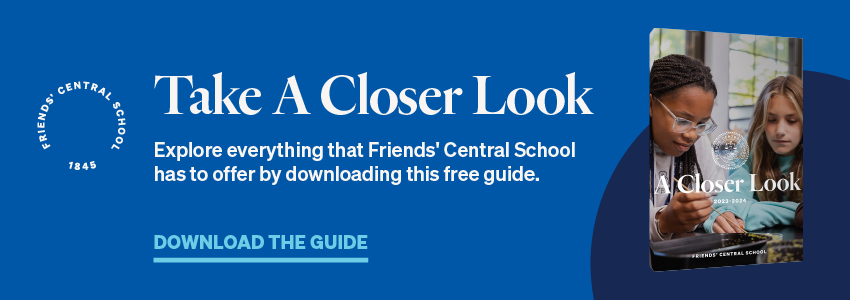
In middle school, students are often faced with new challenges and responsibilities, including adapting to new environments, routines, and realities. This makes middle school a time of great excitement, development, and personal growth, and often serves as a pivotal moment in the lives of most individuals.
The past year, however, has added new elements of change and difficulty to an already vulnerable time of many children’s lives. The COVID-19 pandemic has brought much uncertainty, anxiety, and restriction, and education around the world has seen considerable impacts as a result of the shift to remote learning.
Free Downloadable Guide: Take a Closer Look at Friends' Central School
With this in mind, it is necessary to take a look at some of the unique challenges that middle school students have faced in the past year and may face, in part in the next. The goal is to help parents understand these challenges and also provide advice that you can use to help your child through this unprecedented time.
Top Challenges for Middle Schoolers in 2021
1. Loss of Routines and Structure
Children thrive on set routines and rely on the structure provided to them by their caregivers and educators. These routines provide a level of consistency and certainty that helps children feel confident and grounded as they navigate their surroundings. As they enter middle school, adolescents will typically find these routines changing. The days often begin earlier; after school activities often last longer; and homework often eats up a greater percentage of a child’s time outside of regular school hours.
The transition to middle school during the uncertainty of COVID-19, however, can be especially difficult. Whether students are adapting to a fully remote or a hybrid learning model, the pandemic has presented new challenges. Students have had to adjust to a shift from a traditionally fully in-person learning model to spending at least a portion of their time online. Many students have to learn to juggle their in-school routines and schedules with their at-home learning model and vice versa, including knowing what is expected of them day-to-day and, sometimes, hour-to-hour.
This upheaval can cause stress and anxiety in any child. However, these issues can be mitigated when parents and caregivers maintain routines and normalcy where possible. The traditional schedules children rely on—planned time for self-care, nutrition, exercise, and socialization—can help them feel a sense of control and consistency in a time of uncertainty. This is especially important for remote learners, as a set remote learning routine will provide a sense of predictability and help them balance the expectation of participating in a full “school day” while at home.
2. Changing Learning Formats
Even in a normal year, the transition to middle school often brings with it new learning formats that can sometimes cause growing pains for some children.
Whereas in elementary school it is not uncommon for a student to be taught all subjects by a single teacher, middle school often brings an introduction to rotating classrooms and teachers. Similarly, middle school is also often a time when students will experience a greater level of autonomy in their learning. While most children will find this transition exciting, it is not uncommon for there to be the occasional stumble in the early days.
Likewise, the COVID-19 pandemic has introduced a new layer to this challenge due to the switch to hybrid and fully remote learning models. While a crucial part of fighting the pandemic, especially in the early days, this embrace of technology and learning from home has for some students added a layer of difficulty that in normal years would not have been present.
Parents can support their children through these challenges in part by helping them establish not only the healthy schedule mentioned above, but also by establishing an effective remote learning space.
3. Strained Relationships
In middle school, children are learning to become their own unique selves. During this time, it is not uncommon for children to branch out from their childhood friendships and experiment with developing new relationships that align with their newfound interests. This is completely natural and to be expected. And yet it is not uncommon for some children to feel a sense of loss as they sometimes drift apart from their earliest friends.
For many, the pandemic has only exacerbated this challenge. While social distancing has proven essential to protecting ourselves and others in our community, there is no doubt that, for many, it has led to a sense of isolation as we have all lost time together with those that we love and care about, whether friends, classmates, or members of our family. When socialization does occur, it is often through a computer screen, and it often lacks the warmth, connection, and spontaneity that might come from connecting in person.
The good news is that there is light at the end of the tunnel! Students can, and should, feel excited at the prospect of soon being able to see and hug their friends and loved ones once again. In the meantime, parents should do whatever they can to help their children maintain friendships despite social distancing.
4. Lack of Extracurricular Activities
The extracurricular activities many middle school students rely on to enjoy the full middle school experience are often no longer a reality. After school sports and clubs where they mingle and interact with their fellow students have, in many cases, been suspended or otherwise moved to a digital format in the name of social distancing.
While this new extracurricular reality isn’t ideal, kids should be encouraged to continue to explore their interests and discover what they’re passionate about, even if it’s in a format they don’t traditionally enjoy. Things like the School Yearbook Club, Book Clubs, Language Clubs, and even Student Government are all well-equipped to continue online, and instructors have set up online instruction for everything from dance to cooking to yoga.
As long as your young learner is encouraged to look for them, extracurriculars can still be an integral part of their middle school experience.
Supporting Your Child Through Challenges
Middle schoolers are uniquely poised as individuals who are beginning to see and understand the challenges of the world around them. However, many middle schoolers have not yet developed the healthy coping strategies and life perspective that allows most adults to navigate these uncertain new waters without undue stress and anxiety. This can add additional difficulty to the middle school experience, and provide a roadblock for young learners that is unique to the current climate.
Fortunately for parents and caregivers, the global nature of the COVID-19 pandemic means that the additional challenges of middle school in 2022 are being navigated by all of us. We are all working through this together to ensure that our children have a happy, successful year.
Parents should remember that creating a partnership with their child’s school is their best line of defense in helping their children through this difficult time. At schools like Friends’ Central, for example, your child’s teachers, advisors, and support services can help you identify patterns and behaviors that might be happening at school and at home, and can help you develop strategies and tools to help your child handle any issues.
With the support of parents and caregivers, and the guidance and care of educators and administrators, adolescents will have the right tools to meet this new world head on. If you find that, even with additional support, your child is still experiencing significant difficulties, it may be time to consider switching schools to a more supportive environment.



